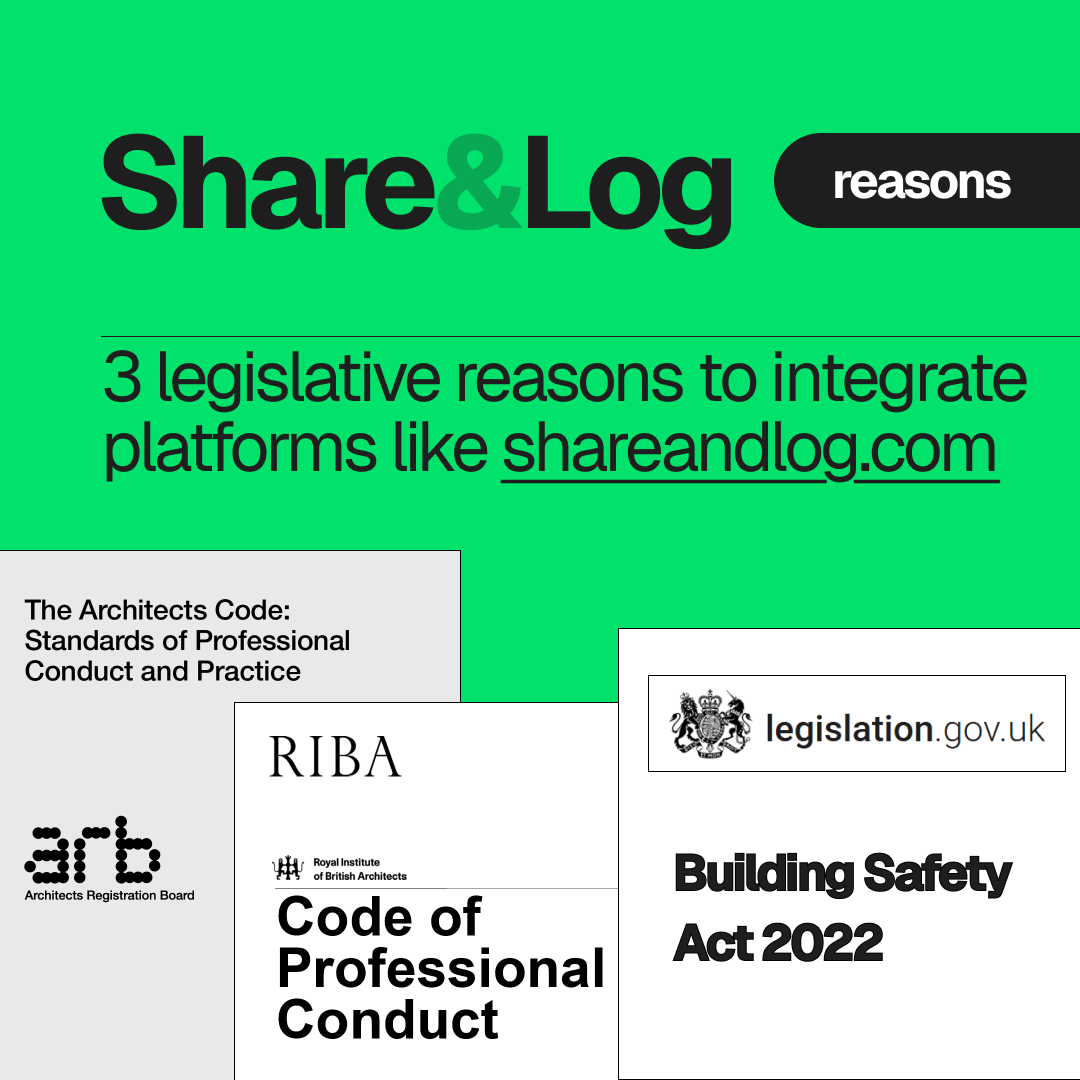Legislative reasons and obligations to keep drawing issue registers up to date

Share and Log is built to streamline essential admin and QA tasks for architects. Whether you are a sole practitioner, small, medium or large architectural practice, keeping clear records of what was issued, when, and to whom remains important. Shareandlog.com simplifies this process — automating drawing issue registers, tracking revisions, and storing metadata. The platform also tracks who issued and received each file, and when downloads occurred—offering full traceability at every stage.
Keeping accurate drawing issue records is a professional obligation – ARB.
The Architects Registration Board (ARB) Code of Conduct requires architects to maintain appropriate records that demonstrate professional decision-making, safeguard client information, and meet legal and regulatory duties. This includes tracking what information was issued, when, and to whom. In the event of a dispute, audit, or complaint, drawing issue registers often form critical evidence. Consistent record-keeping is a key part of acting with integrity and accountability and it helps protect both clients and architects.
📘 ARB Code of Conduct Requirements
Standard 4 – Competent management of your business
"4.1 You are expected to have effective systems in place to ensure that your practice is run professionally and that projects are regularly monitored and reviewed."
Standard 6 – Working conscientiously and with due regard to relevant technical and professional standards
"You should carry out your professional work with skill and care… keep your client informed of the progress of work… and of any issue which may significantly affect its quality or cost." Maintaining accurate records underpins these duties. Architects Registration Board
Standard 11 – Co-operation with regulatory requirements and investigations
"You are expected to co operate fully and promptly with ARB… if it asks you to provide information which it needs to carry out its statutory duties…" Complete, accessible records—from drawing registers to metadata—are essential here. Architects Registration Board
Supporting RIBA's standards through detailed documentation.
The RIBA Code of Professional Conduct (2005) highlights the importance of accurate documentation as part of competent practice. Members are expected to record terms of appointment, monitor project decisions, and keep clients informed—obligations that directly rely on having structured records in place. Drawing issue registers, revision logs, and correspondence records form the foundation for transparency, client trust, and professional accountability.
📘 RIBA Code of Professional Conduct (2005)
Principle 2 – Competence
"Members are expected to apply high standards of skill, knowledge and care in all their work."
Section 2.3
"Members should ensure that their terms of appointment, the scope of their work and the essential project requirements are clear and recorded in writing… Members should maintain appropriate records throughout their engagement."
Section 2.4
"Members should keep their clients informed of the progress of a project and of the key decisions made on the client's behalf."
The Building Safety Act places clear responsibilities on designers to manage and maintain project information.
The Act introduces clear duties for designers, including sole practitioners, particularly when acting as dutyholders (e.g. Principal Designer). Dutyholders must ensure that accurate, up-to-date digital records are created, maintained, and made available throughout a building's lifecycle.
📘 Building Safety Act 2022 – Key Duties
Section 33, Schedule 1, Paragraph 1D – Keeping and giving information
"Building regulations may… make provision about obtaining, keeping and giving information and documents… including requirements as regards keeping information or documents up to date."
Building Safety Act 2022, Section 33, Schedule 1 (see Paragraph 1D)
Conclusion
Whether required by professional codes or legislation, keeping clear, consistent records is not optional - it is a core part of architectural responsibility. From the ARB's Code of Conduct and RIBA's professional standards to the Building Safety Act's dutyholder requirements, the message is clear: reliable documentation protects clients, safeguards practices, and upholds public trust. For sole practitioners and small firms, meeting these obligations need not be burdensome - but it must be taken seriously. Putting simple, structured systems in place for recording drawing issues and revisions is a practical step towards better compliance, accountability, and peace of mind.
This is exactly where shareandlog.com can help. The platform is designed to offer simple, fast, and effective QA compliance tools that are easy to use - even for sole practitioners - while remaining affordable for smaller practices. No demo calls or onboarding meetings - just register and start using it.